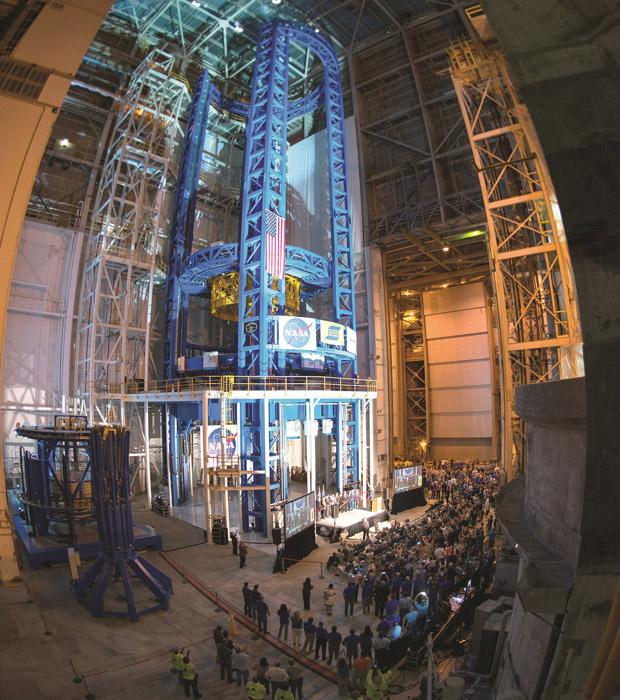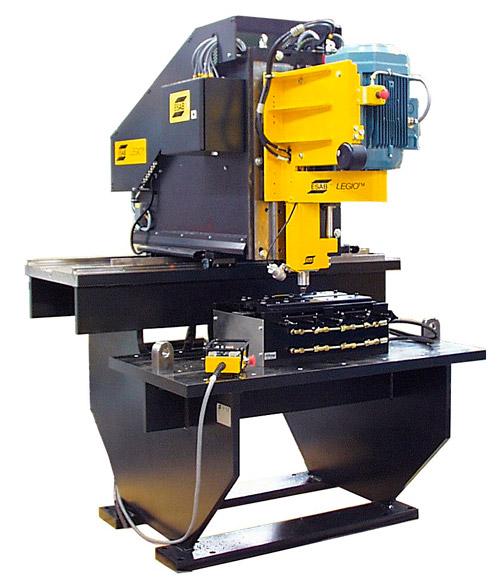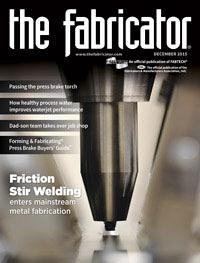Welding Automation Sales Manager
- FMA
- The Fabricator
- FABTECH
- Canadian Metalworking
Categories
- Additive Manufacturing
- Aluminum Welding
- Arc Welding
- Assembly and Joining
- Automation and Robotics
- Bending and Forming
- Consumables
- Cutting and Weld Prep
- Electric Vehicles
- En Español
- Finishing
- Hydroforming
- Laser Cutting
- Laser Welding
- Machining
- Manufacturing Software
- Materials Handling
- Metals/Materials
- Oxyfuel Cutting
- Plasma Cutting
- Power Tools
- Punching and Other Holemaking
- Roll Forming
- Safety
- Sawing
- Shearing
- Shop Management
- Testing and Measuring
- Tube and Pipe Fabrication
- Tube and Pipe Production
- Waterjet Cutting
Industry Directory
Webcasts
Podcasts
FAB 40
Advertise
Subscribe
Account Login
Search
Friction stir welding expands its scope
The advanced joining technology is not just used for advanced aerospace applications
- By Martin Brennan
- November 30, 2015
- Article
- Shop Management
When friction stir welding (FSW) was invented in 1991, it was considered to be more of a laboratory curiosity than a fabrication process with broad application. Advances in the technology have changed this thinking and made FSW a versatile and innovative welding method that continues to mature.
FSW is a solid-state process, which means the base materials to be joined do not melt during welding but are plasticized, similar to joining clay together (see Figure 1). Fast, high-quality welds of 2xxx and 7xxx series alloys, traditionally considered unweldable, are possible using FSW. It can also successfully weld numerous alloys and materials, including high-strength steels, stainless steel, titanium, and simple carbon steel. It can even be used to join dissimilar materials.
FSW has changed the way components for aerospace, defense, shipbuilding, transportation, medical, and electronics are fabricated, and its scope is expanding to more industries and applications.
What does it take to bring this welding process to the production floor?
Making the Business Case for Friction Stir Welding
A friction stir welding system can cost the same as a very basic press brake or a modern laser cutting machine with advanced material handling automation. It depends on the application.
To justify the investment, it’s important to go beyond the capital cost and focus on the big picture. The low heat input that occurs during the joining process and the resulting high-strength welds have the potential to change the way many common structures are built. The process produces welds with increased tensile strength, outstanding fatigue properties, and improved corrosion resistance, all while creating minimal distortion and shrinkage. FSW allows manufacturers to redesign components for lighter weight, lower cost, and higher performance.
When considering an automated FSW system, which costs more than conventional welding equipment, a fabricator needs to take into account all aspects of the operation to determine return on investment. For example, FSW requires no welding consumables such as shielding gas, wire, liners, or tips.
FSW stands out in other ways:
- Preweld setup is simple. Degreasing and surface cleaning of the material’s weld path is all that’s needed.
- FSW welds three to four times faster than gas metal arc welding (GMAW) in most aluminum materials. With automated FSW equipment, the typical production speed to join 0.20-inch AA6082 extruded profiles is 10 feet per minute (3 meters per minute).
- Material thicknesses from 0.02 to 2.56 in. (0.5 to 65 mm) can be welded from one side at full penetration, without porosity or internal voids (often a challenge when arc welding aluminum).
- Joint quality is superior to conventional fusion-welded joints. The solid-state process produces virtually zero defects. Tensile strength is high, and the appearance of the weld is improved over conventional welding.
- The high quality of the weld, consistently straight and dimensionally accurate, requires no secondary processing or postweld heat treatment in most cases (see Figure 2).
- Because the process doesn’t require shielding gas, a fabricator doesn’t require an investment in pressure tanks, pipe fittings, and gas regulators. This also eliminates the need for storage and transport of consumables in the production area.
- Generally, FSW demands less energy input to the weld than GMAW or gas tungsten arc welding (GTAW). FSW is always a single-pass process, offering greater energy savings as wall thickness increases.
- FSW generates no noise, sparks, or fumes. This eliminates the need for fume extraction equipment or added measures to protect workers from UV or IR radiation.
Bringing FSW to the Production Floor
FSW equipment comes in varying configurations, from simple CNC production machines the size of a dining room table to the largest spacecraft welding tool built, which stands 170 feet tall, is 78 ft. in diameter, and weighs more than 3 million pounds (see Figure 3).
For general production of simple butt/lap joint welds, a modular system offers flexibility and economy and brings the technology to a broader base of users (see Figure 4). These systems are designed for welding depths from 0.02 to 2.56 in. (0.5 to 65 mm) and for production of small to medium-sized components and small batches in varied sizes, such as electronic enclosures, flat panels, and heat exchangers. The welding head travels on heavy-duty linear bearings and is driven by a rack-and-pinion drive system. Modular systems are built for easy integration with larger fixtures, rotary units, and exchangeable clamping systems.

Figure 1
In friction stir welding, a rotating, nonconsumable, pin-shaped tool penetrates the material and generates frictional heat, softening the material and enabling the weld to be completed in a single pass.
Robotic systems tackle more challenging applications (see Figure 5). Designed for complex joints, particularly in the aluminum 6000 series, robotic systems feature full FSW integration. The robot is modified for the FSW process and can apply a downforce of up to 13 kN (2,922 ft.-lbs.), suitable for welding 5xxx aluminum up to 0.24 in. (6 mm).
This equipment provides high flexibility and unrestricted reach up to 8.2 ft. (2.5 m) for applications beyond flat linear joints. Advanced controls with embedded force control ensure high-accuracy, in-contact motion. Sophisticated motion software permits linear welding in arbitrary patterns and circular and square paths. Robotic FSW systems are designed to adapt to production changes and to be easily reconfigured for new applications.
Custom-designed systems handle high-volume production of large aluminum panels, girders, and trusses. System configurations, which include gantry style, column and boom, and seam welder, vary depending on the application demands.
In a fully automated system, the machine control, specially developed for FSW, manages all critical variables and can be monitored remotely from any PC using a standard Ethernet connection. Large-scale equipment is used in aerospace (cryogenic tanks for rockets, space capsules, airframe structures), marine and shipbuilding (panel welding, long linear welds, stiffened panels), oil and gas (fuel tanks, storage tanks), and transportation (railcars, truck frames) applications.
No matter the size or style of equipment, any fabricator that is interested in this type of welding process needs to understand some of the following basic fundamentals before investing in the equipment.
Welding Speed. The welding speed of the system depends on the welding tool, joint type, alloy, material thickness, and stability of the welding machine and fixture station.
Welding Force. FSW equipment must be designed for high welding forces. In FSW, a cylindrical shouldered tool with a profiled pin is rotated and plunged into the joining area between two pieces of sheet or plate material. Parts must be securely clamped in a way that prevents the joint faces from being forced apart. A 0.20-in.- (5-mm-) thick 6082 T6 butt joint can be welded at low speed with a specific downforce, but the same welding at 20 FPM (6 m/min.) requires a downforce that is eight to 10 times higher.
Surface Contact. Good surface contact with the workpiece must be maintained constantly. Otherwise, friction will decrease, and the quality of the weld will suffer. The best welding result comes from equipment having force control. With force control, the system monitors downforce to maintain force accuracy throughout the welding process. This ensures full contact with the material at all times.
Tool Design. Welding tool design is critical in FSW. Optimizing tool geometry to produce more heat or achieve more efficient “stirring” offers two main benefits: improved breaking and mixing of the oxide layer and more efficient heat generation, yielding higher welding speeds and better quality.
Tool materials should have relatively high hardness at elevated temperatures and retain this hardness for an extended period. The combination of tool material and base material is critical to the tool’s operational lifetime. When welding single-sided extruded profiles in the Al 6000 series with a 0.20-in. (5-mm) material thickness, it’s typical to weld nearly 5,000 FPM (1,500 m/min.) with one tool, which corresponds to more than 100 panels.
Resistance to wear (durability) is an important aspect of tools for welding steel. To apply FSW in steel or other high-temperature materials, the tool material must withstand the high temperatures (approximately 1,200 degrees F) that occur during the process. In these applications, tools with a polycrystalline cubic boron nitride tip are the most effective.
More Applications Ahead
The best candidates for FSW are long, longitudinal weld configurations in butt, lap, combination butt/lap, and fillet joints on aluminum. All light metals, including aluminum alloys, copper alloys, magnesium, zinc, and lead, can be industrially friction stir welded. A number of high-melting-temperature alloys are also successfully joined using FSW (see Figure 6).
As aluminum is used more commonly in transport vehicles like trucks and trailers to reduce the “dead-load” and increase the payload, and as environmental concerns call for reduced weight in many road applications, FSW is a good production option. With many straight linear welds and easily weldable materials in thicknesses typically up to 0.20 in. (5 mm), truck components are ideal for the process.
Transportation applications also include telescopic lift booms. Made of four 7000 series profiles, the booms are 28 ft. (8.5 m) long, have a thickness range of 0.20 to 0.39 in. (5 to 10 mm), and are welded at speeds up to 3.3 FPM (1 m/min).
Automotive applications with large manufacturing batches, Six Sigma requirements, and challenging material combinations such as aluminum and magnesium alloys are a suitable fit for FSW. In one such application, welding seat frames, FSW cycle time was less than one minute per seat using dual FSW heads.
Electronic devices can benefit from FSW as well. In one example, a loudspeaker frame made of cast aluminum is friction stir welded. This results in no heat-induced deformations in the final product and a solid structure with good acoustics.
In another example, FSW played a key part in the redesign of a cooling block for a heavy-duty cutting machine. Instead of using one large extrusion, the new design friction stir welds together two profiles to form one structure for a more cost-effective production method. The penetration on the weld is approximately 0.60 in. (15 mm).
In the energy industry, orbital FSW is used to create welds for land and offshore pipelines. FSW of up to 0.5-in. (12.7-mm) maximum on X65 through X100 steels is highly repeatable. The process is much more energy-efficient than arc or laser welding, so energy consumption can be reduced by 60 percent to 80 percent.
Copper canisters for spent nuclear fuel are sealed successfully using FSW. The challenges in welding thick copper are high welding temperatures up to 1,743 degrees F, high welding forces, and the duration of the weld (up to one hour). FSW is able to address these severe demands.
Virtually anywhere aerospace or civil aviation equipment is being manufactured, FSW production technology is being considered for future designs, including those for carrier beams, floors, and complete fuselages and wings. Boeing has used the technology to manufacture rocket fuel tanks. Production time for a typical tank is reduced dramatically and a number of cost savings achieved, especially when compared to the cost of riveting.

Figure 3
NASA’s heavy-lift rocket, the Space Launch System, being manufactured in conjunction with Boeing, is a high-profile FSW application. The Vertical Assembly Center (VAC) is a giant circumferential welding system that uses FSW to precision-weld the fuel tank structures for the rocket. Its weld head and clamp positional accuracy and repeatability hold a weld tolerance of less than 0.015 in. (0.38 mm).
A next step for FSW is joining of superplastically formed products. Applications include manufacturing automotive door components. In superplastic forming, pressurized gas is used to impart the product’s final shapes.
As new areas are explored, more applications are proving suitable for this cold weld process.
About the Author
Martin Brennan
411 S. Ebenezer Road
Florence, SC 29501
843-669-4411
Related Companies
subscribe now

The Fabricator is North America's leading magazine for the metal forming and fabricating industry. The magazine delivers the news, technical articles, and case histories that enable fabricators to do their jobs more efficiently. The Fabricator has served the industry since 1970.
start your free subscription- Stay connected from anywhere

Easily access valuable industry resources now with full access to the digital edition of The Fabricator.

Easily access valuable industry resources now with full access to the digital edition of The Welder.

Easily access valuable industry resources now with full access to the digital edition of The Tube and Pipe Journal.
- Podcasting
- Podcast:
- The Fabricator Podcast
- Published:
- 04/16/2024
- Running Time:
- 63:29
In this episode of The Fabricator Podcast, Caleb Chamberlain, co-founder and CEO of OSH Cut, discusses his company’s...
- Trending Articles
Capturing, recording equipment inspection data for FMEA

Tips for creating sheet metal tubes with perforations

Are two heads better than one in fiber laser cutting?

Supporting the metal fabricating industry through FMA

Hypertherm Associates implements Rapyuta Robotics AMRs in warehouse

- Industry Events
16th Annual Safety Conference
- April 30 - May 1, 2024
- Elgin,
Pipe and Tube Conference
- May 21 - 22, 2024
- Omaha, NE
World-Class Roll Forming Workshop
- June 5 - 6, 2024
- Louisville, KY
Advanced Laser Application Workshop
- June 25 - 27, 2024
- Novi, MI





























